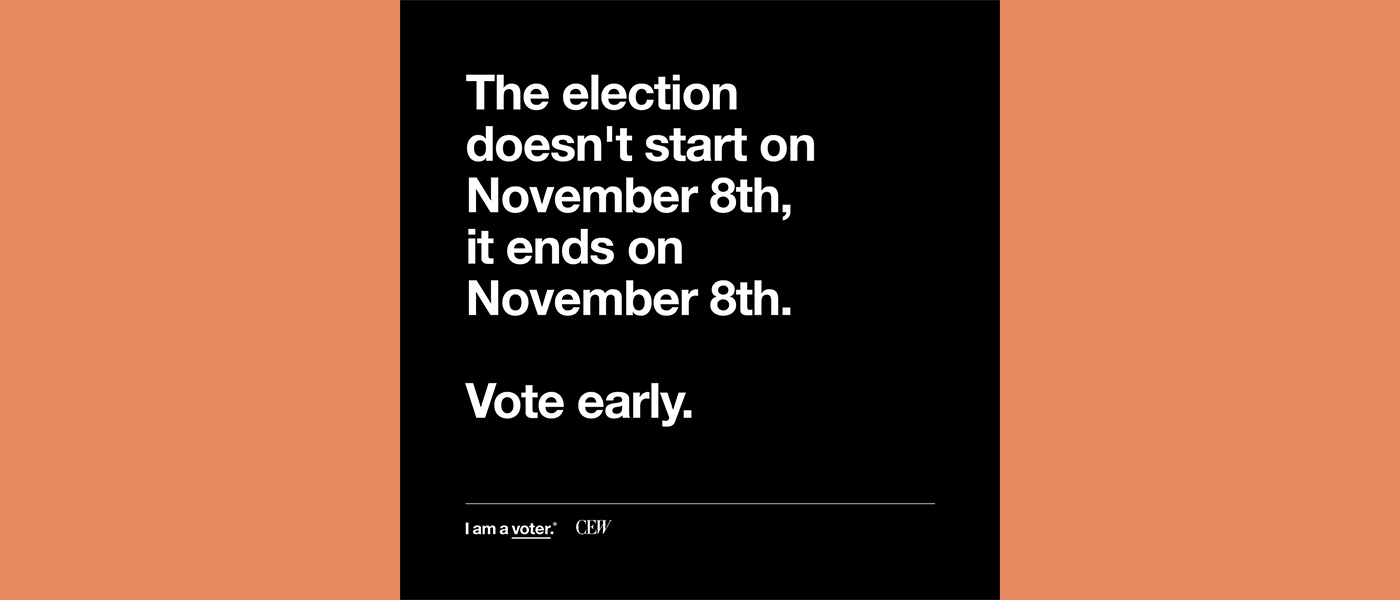Vote yourself — then remind your friends and social networks to vote early or on Tuesday, November 8, for the midterm elections with nonpartisan social media posts from I Am a Voter.
Dear CEW Members,
I am writing you to join CEW in our effort to get our Members, friends, and family to vote in the upcoming midterm elections on Tuesday, November 8.
For over 65 years, CEW’s mission has been to empower women professionally and personally. In anticipation of such an important election, no matter your views, we have partnered with the non-profit I Am a Voter to encourage you to ask your networks to use their right to vote by posting one of these downloadable social assets.
We will be forever grateful.
Best,
Carlotta

Interested in adding a stat to your caption about why midterm voting matters so much? We’ve curated a brief list for you here:
FEMALE VOTERS
- Women are registered to vote in the U.S. at higher rates than men. In recent years, the number of women registered to vote in the U.S. has typically been about 10 million more than the number of men registered to vote. (Source: Center for American Women and Politics at Rutgers)
- The number of female voters has exceeded the number of male voters in every presidential election since 1964 (though the gender gap in the turnout rates and numbers tends to narrow in non-presidential election years). (Sources: Center for American Women and Politics at Rutgers; Pew Research)
YOUNG VOTERS & FIRST-TIME VOTERS
- More than one in five newly eligible voters (ages 18 to 21) who were not registered to vote said it was because they did not know how to register. (Source: CIRCLE at Tufts University)
- An estimated eight million Americans who were too young to vote in 2020 will be able to vote and make history in 2022 (Source: CIRCLE at Tufts University)
- According to 2020 exit polls, 13% of people who voted for president in 2020 cast ballots for the first time, compared to under 10% in 2016. (Source: NBC News)
- Young people, people of color, and unmarried women make up 64% of eligible voters. (Source: Voter Participation Center)
- Millennials and Gen Z may account for nearly 45% of eligible voters by 2024. (Source: Center for American Progress)
BLACK VOTERS
- Black Americans are projected to account for 13.6% of all eligible voters in the United States in the midterms, and the number of eligible Black voters is projected to reach 32.7 million by November. (Source: Pew)
- As of 2020, eight states are home to about half of all eligible Black voters in the United States. Texas has the largest number, with 2.7 million, followed by Georgia and Florida (each with 2.5 million). Rounding out the top eight are New York (2.3 million), California (2.0 million), North Carolina (1.8 million), and Maryland and Illinois (1.4 million each). (Source: Pew)
- Black voters made up nearly half (46%) of all eligible voters in the District of Columbia in 2020 — a higher share than any state. Other places with large shares of eligible Black voters are Mississippi (35%), Georgia (33%), Louisiana (32%), and Maryland (32%). (Source: Pew)
- In 2020, Black turnout reached 70% across eight competitive states where the presidential election was decided by fewer than five percentage points, up from 63% in 2016, and rising turnout among Black voters had the clearest impact in Georgia. (Source: The Washington Post; Georgia State Election Board)
LATINx VOTERS
- The Latinx community is the fastest-growing racial and ethnic group in the U.S. electorate since the last midterm election. (Source: Pew)
- Latinx people are projected to account for 14.3% of all eligible voters in November 2022, a new high. (In 2000, Latinx individuals made up 7.4% of eligible U.S. voters.) (Source: Pew)
- California is home to about a quarter of all eligible Latinx voters, and in New Mexico, 44% of all eligible voters are Latinx — the highest share of any state. (Source: Pew)
LGBTQIA VOTERS
- LGBTQIA voters represented 7% of the 2020 electorate, while representing 4.5% of the adult population. LGBTQIA voters represented 6% of the electorate in the 2018 midterm election. (Source: The New York Times)
- 21% of LGBTQIA people aren’t registered to vote compared to 17% of non-LGBTQIA individuals. (Source: Williams Institute at UCLA Law)
- In 2020, more than a quarter of all trans people in the country didn’t have an ID that correctly reflected their identity, which could make them ineligible to vote. (Source: Williams Institute at UCLA Law)
- According to a Human Rights Campaign survey, more than 60% of all BIPOC trans people eligible to vote chose not to or were unable to because of ID issues.
- From our friends at VoteRiders and HeadCount, here is a great resource for and about voter ID for trans and non-binary voters.




